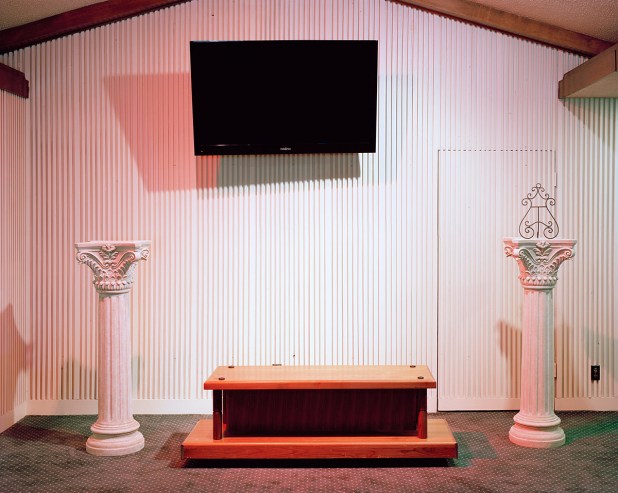Posts Tagged ‘requiem’
“I did not attend his funeral, but I sent a nice letter saying I approved of it”*…
Do not let the “new age” label fool you—David Young’s music is damn catchy. With simple melodies, played on the recorder and repeated with slight variations, the songs run through my head hours after listening, and I’m not exactly a new-age fan. Young’s catalog covers a who’s who of adult contemporary—from Miguel Bosé’s “Lay Down on Me” to “Con te partirò”—but even the melodies in his original songs exude a similar familiarity. Young may not work for Muzak, but his music sure sounds like he’s studied their scores.
From a wardrobe of puffy shirts to the gimmick of playing two recorders at once, David Young seems about as cheesy as new-age music gets—think Tim Robbins’s character in High Fidelity, but with less home-wrecking libido and more harpsichord. But, non-threatening as the image may be, this self-described “pied piper of romantic music for the 21st century” has independently released more than 16 albums, including Celestial Winds, Renaissance, and Songs of Hope, and claims to have sold more than one million copies (500,000 in 2002 alone!).
I first learned about David Young from an ad in the quarterly trade magazine of the Dodge Company, the world’s largest supplier of mortuary chemicals. The Spring 2008 issue of Dodge Magazine included articles on “airbrushing cosmetics for funeral professionals” and how funeral directors should respond in the case of a mass murder in a small-town shopping mall (be “like French waiters…[who can] do the job and not be noticed”). In addition to embalming chemicals, Dodge also has a hand in the sale and distribution of miscellaneous funerary goods—including memorial collages of softly lit photos that “make women squeal with delight when they see the portraits for the first time.”
That there is a “funeral industry” in the first place can seem morbid and indecent. Anyone who remembers Six Feet Undermay feel they know the ins and outs, but the reality is certainly more disturbing. Flipping through a trade magazine advertising “vibrant” urns and pink-hued arterial conditioners does nothing to contradict this impression, nor does Young’s ad. In the full-page color layout, Young’s musical oeuvre is described as “perfect background music for your funeral home.” Wearing dangerously tight pants and a puffy shirt coyly unbuttoned to reveal a shadow of chest hair, David Young hawks a new age of new-age music for funerals. “In emotional times such as these,” the ad claims, “it’s important to set the right tone.”
In 2004, Craig Caldwell of the Dodge Company met Young at a funeral directors’ trade show in Chicago. Impressed, Caldwell made a distribution arrangement with the musician and has since been selling Young’s recordings to his clients—funeral directors who rely on Dodge for everything from embalming fluid to a disinfectant called Lemocide. On the phone from his office, Caldwell explained that the music’s emotional restraint, being “lighter, airier, more enticing to sharing feelings and thoughts, than dirges,” made it seem like a good match for funeral homes. This preference for lightness mirrors other changes in modern funerals, a business that, though still traditional by many accounts, is becoming increasingly secular and informal. “People rarely wear black to funerals anymore,” Caldwell told me when I interviewed him in 2008. “Except for the older generation. But children today, they don’t even wear a coat and a tie anymore.”
Young is the theme song to your grandmother’s memorial, the pop radio of your cousin’s wake. That funeral homes now have a soundtrack, one that provides us with a subtle, uncomplicated sense of recognition—as minimalist guru Brian Eno would call it, an ambience—shouldn’t be a surprise. Rather than a nuisance or intrusion, this easy listening could be a way of mitigating disruptive grief.
…
Many of America’s funeral parlors rely on one man to provide the theme music for your grandmother’s memorial service, the pop radio for your cousin’s wake. Welcome to “semi-spiritual” ambient music and the stuff of contemporary mourning: “Songs in the Key of Death,” from The Morning News.
Image above from the series “More Scena” by photographer Rachel Cox, via BOOOOOOOM.
* Mark Twain
###
As we acclimate to ambience, we might send melodic birthday greetings to Claudio Giovanni Antonio Monteverdi; he was born on this date in 1567 (or so it is believed; we know for sure that he was baprised on May 15 of that year). A composer, string player, choirmaster, and priest who created both secular and sacred music, he was a pioneer in the development of opera, and is considered a crucial transitional figure between the Renaissance and Baroque periods of music history.
Much of Monteverdi’s output, including many stage works, has been lost. His surviving music includes nine books of madrigals, large-scale religious works, such as his Vespro della Beata Vergine (Vespers for the Blessed Virgin) of 1610, and three complete operas. His opera L’Orfeo (1607) is the earliest of the genre still widely performed; towards the end of his life he wrote works for Venice, including Il ritorno d’Ulisse in patria and L’incoronazione di Poppea.
Among his works were several funerary pieces, including a Requiem Mass for Cosimo II de’ Medici (in 1621).


You must be logged in to post a comment.